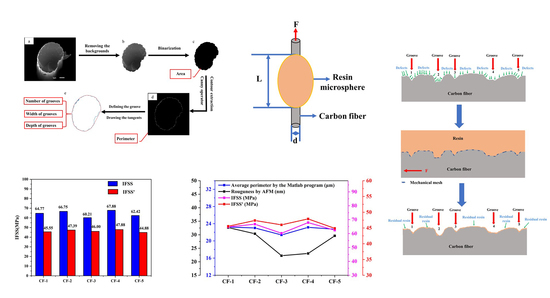Effect of Carbon Fiber Surface Microstructure on Composite Interfacial Property Based on Image Quantitative Characterization Technique
Abstract
:1. Introduction
2. Materials and Methods
2.1. Materials
2.2. Characterization
2.3. Quantitative Characterization of CF Surface Physical Structure
2.3.1. Image Preprocessing
2.3.2. Calculation of CF Cross-Section Perimeter and Area
2.3.3. Calculating CF Surface Groove Structure Parameters
3. Results and Discussion
3.1. Cross-Section and Surface Morphology of CFs
3.2. Quantitative Characterization Results of CF Surface Microstructure
3.3. Groove Parameters and Surface Roughness of CFs
3.4. Specific Surface Area and Cross-Section Perimeter of CFs
3.5. Composite Interfacial Property and CF Surface Microstructure
3.6. Interface Bonding Mechanism of CF Composites
4. Conclusions
Author Contributions
Funding
Institutional Review Board Statement
Informed Consent Statement
Data Availability Statement
Acknowledgments
Conflicts of Interest
References
- Lionetto, F.; Morillas, M.N.; Pappadà, S.; Buccoliero, G.; Fernandez Villegas, I.; Maffezzoli, A. Hybrid welding of carbon-fiber reinforced epoxy based composites. Compos. Part A Appl. Sci. Manuf. 2018, 104, 32–40. [Google Scholar] [CrossRef]
- Williams, G.; Trask, R.; Bond, I. A self-healing carbon fibre reinforced polymer for aerospace applications. Compos. Part A Appl. Sci. Manuf. 2007, 38, 1525–1532. [Google Scholar] [CrossRef]
- Das, T.K.; Ghosh, P.; Das, N.C. Preparation, development, outcomes, and application versatility of carbon fiber-based polymer composites: A review. Adv. Compos. Hybrid Mater. 2019, 2, 214–233. [Google Scholar] [CrossRef]
- Shaikh, H.; Gulrez, S.K.H.; Anis, A.; Poulose, A.M.; Qua, P.E.H.; Yadav, M.K.; Al-Zahrani, S.M. Progress in Carbon Fiber and Its Polypropylene- and Polyethylene-Based Composites. Polym.-Plast. Technol. Eng. 2014, 53, 1845–1860. [Google Scholar] [CrossRef]
- Karger-Kocsis, J.; Mahmood, H.; Pegoretti, A. Recent advances in fiber/matrix interphase engineering for polymer composites. Prog. Mater. Sci. 2015, 73, 1–43. [Google Scholar] [CrossRef]
- Ma, Q.; Gu, Y.; Li, M.; Wang, S.; Zhang, Z. Effects of surface treating methods of high-strength carbon fibers on interfacial properties of epoxy resin matrix composite. Appl. Surf. Sci. 2016, 379, 199–205. [Google Scholar] [CrossRef]
- Sha, Z.; Han, Z.; Wu, S.; Zhang, F.; Islam, M.S.; Brown, S.A.; Wang, C.-H. Low-temperature plasma assisted growth of vertical graphene for enhancing carbon fibre/epoxy interfacial strength. Compos. Sci. Technol. 2019, 184, 107867. [Google Scholar] [CrossRef]
- Yuan, X.; Zhu, B.; Cai, X.; Liu, J.; Qiao, K.; Yu, J. Optimization of interfacial properties of carbon fiber/epoxy composites via a modified polyacrylate emulsion sizing. Appl. Surf. Sci. 2017, 401, 414–423. [Google Scholar] [CrossRef]
- Ma, L.; Meng, L.; Fan, D.; He, J.; Yu, J.; Qi, M.; Chen, Z.; Huang, Y. Interfacial enhancement of carbon fiber composites by generation 1–3 dendritic hexamethylenetetramine functionalization. Appl. Surf. Sci. 2014, 296, 61–68. [Google Scholar] [CrossRef]
- Yu, B.; Jiang, Z.; Tang, X.-Z.; Yue, C.Y.; Yang, J. Enhanced interphase between epoxy matrix and carbon fiber with carbon nanotube-modified silane coating. Compos. Sci. Technol. 2014, 99, 131–140. [Google Scholar] [CrossRef]
- Yao, X.; Gao, X.; Jiang, J.; Xu, C.; Deng, C.; Wang, J. Comparison of carbon nanotubes and graphene oxide coated carbon fiber for improving the interfacial properties of carbon fiber/epoxy composites. Compos. Part B Eng. 2018, 132, 170–177. [Google Scholar] [CrossRef]
- Zhang, R.L.; Gao, B.; Ma, Q.H.; Zhang, J.; Cui, H.Z.; Liu, L. Directly grafting graphene oxide onto carbon fiber and the effect on the mechanical properties of carbon fiber composites. Mater. Des. 2016, 93, 364–369. [Google Scholar] [CrossRef]
- Song, B.; Wang, T.; Sun, H.; Liu, H.; Mai, X.; Wang, X.; Wang, L.; Wang, N.; Huang, Y.; Guo, Z. Graphitic carbon nitride (g-C3N4) interfacially strengthened carbon fiber epoxy composites. Compos. Sci. Technol. 2018, 167, 515–521. [Google Scholar] [CrossRef]
- Hao, J.-W.; Zhao, Y.; Luo, Y.-F.; Wang, Y.; Chen, D. Experiments and finite element simulation of interfacial properties for monofilament composites. New Carbon Mater. 2014, 29, 176–185. [Google Scholar] [CrossRef]
- Sato, M.; Imai, E.; Koyanagi, J.; Ishida, Y.; Ogasawara, T. Evaluation of the interfacial strength of carbon-fiber-reinforced temperature-resistant polymer composites by the micro-droplet test. Adv. Compos. Mater. 2017, 26, 465–476. [Google Scholar] [CrossRef]
- Wang, Z.; Almeida, J.H.S., Jr.; St-Pierre, L.; Wang, Z.; Castro, S.G.P. Reliability-based buckling optimization with an accelerated Kriging metamodel for filament-wound variable angle tow composite cylinders. Compos. Struct. 2020, 254, 112821. [Google Scholar] [CrossRef]
- Almeida, J.H.S.; Bittrich, L.; Spickenheuer, A. Improving the open-hole tension characteristics with variable-axial composite laminates: Optimization, progressive damage modeling and experimental observations. Compos. Sci. Technol. 2020, 185, 107889. [Google Scholar] [CrossRef]
- Li, J.; Yu, Y.; Li, H.; Liu, Y. Polyacrylonitrile based carbon fibers: Spinning technology dependent precursor fiber structure and its successive transformation. J. Appl. Polym. Sci. 2021, 138, 50988. [Google Scholar] [CrossRef]
- Gao, Q.; Jing, M.; Wang, C.; Chen, M.; Zhao, S.; Wang, W.; Qin, J. Mesopores variation in polyacrylonitrile fibers during dry-jet wet spinning process. Iran. Polym. J. 2019, 28, 259–269. [Google Scholar] [CrossRef]
- Al Aiti, M.; Das, A.; Kanerva, M.; Jarventausta, M.; Johansson, P.; Scheffler, C.; Gobel, M.; Jehnichen, D.; Brunig, H.; Wulff, L.; et al. Dry-Jet Wet Spinning of Thermally Stable Lignin-Textile Grade Polyacrylonitrile Fibers Regenerated from Chloride-Based Ionic Liquids Compounds. Materials 2020, 13, 3687. [Google Scholar] [CrossRef] [PubMed]
- Kaur, J.; Millington, K.; Smith, S. Producing high-quality precursor polymer and fibers to achieve theoretical strength in carbon fibers: A review. J. Appl. Polym. Sci. 2016, 133. [Google Scholar] [CrossRef] [Green Version]
- An, F.; Zhou, P.; Lu, C.; Liu, Y. Tuning the surface grooves of carbon fibers by dry-jet gel-spinning. Carbon 2019, 143, 200–203. [Google Scholar] [CrossRef]
- Zhang, S.-J.; Wang, R.-M.; Liao, Y.-Q. A comparative study of two kinds of T800 carbon fibers produced by different spinning methods for the production of filament-wound pressure vessels. New Carbon Mater. 2019, 34, 578–586. [Google Scholar] [CrossRef]
- Zhao, R.-X.; Sun, P.-F.; Liu, R.-J.; Ding, Z.-H.; Li, X.-S.; Liu, X.-Y.; Zhao, X.-D.; Gao, Z.-M. Influence of heating procedures on the surface structure of stabilized polyacrylonitrile fibers. Appl. Surf. Sci. 2018, 433, 321–328. [Google Scholar] [CrossRef]
- Qian, X.; Zou, R.; Ou Yang, Q.; Wang, X.; Zhang, Y. Surface structural evolvement in the conversion of polyacrylonitrile precursors to carbon fibers. Appl. Surf. Sci. 2015, 327, 246–252. [Google Scholar] [CrossRef]
- Chen, L.; Du, Y.; Huang, Y.; Ng, P.F.; Fei, B. Facile fabrication of hierarchically structured PBO-Ni(OH)2/NiOOH fibers for enhancing interfacial strength in PBO fiber/epoxy resin composites. Compos. Sci. Technol. 2016, 129, 86–92. [Google Scholar] [CrossRef]
- Chen, L.; Hu, Z.; Zhao, F.; Xing, L.; Jiang, B.; Huang, Y. Enhanced interfacial properties of PBO fiber via electroless nickel plating. Surf. Coat. Technol. 2013, 235, 669–675. [Google Scholar] [CrossRef]
- Chen, J.; Wang, K.; Zhao, Y. Enhanced interfacial interactions of carbon fiber reinforced PEEK composites by regulating PEI and graphene oxide complex sizing at the interface. Compos. Sci. Technol. 2018, 154, 175–186. [Google Scholar] [CrossRef]
- Li, N.; Chen, J.; Liu, H.; Dong, A.; Wang, K.; Zhao, Y. Effect of preheat treatment on carbon fiber surface properties and fiber/PEEK interfacial behavior. Polym. Compos. 2018, 40, E1407–E1415. [Google Scholar] [CrossRef]
- Ruan, R.; Cao, W.; Xu, L. Quantitative characterization of physical structure on carbon fiber surface based on image technique. Mater. Des. 2020, 185, 108225. [Google Scholar] [CrossRef]
- Yang, T.; Zhao, Y.; Chen, W.; Liu, H. Effect of carbon fiber surface microstructure on mechanical properties of CCF800. J. Mater. Res. Technol. 2020, 9, 8714–8722. [Google Scholar] [CrossRef]
- Rahmani, N.; Willard, B.; Lease, K.; Legesse, E.T.; Soltani, S.A.; Keshavanarayana, S. The effect of post cure temperature on fiber/matrix adhesion of T650/Cycom 5320-1 using the micro-droplet technique. Polym. Test. 2015, 46, 14–20. [Google Scholar] [CrossRef]
- Deng, Y.; Islam, M.S.; Tong, L. Effects of grafting strength and density on interfacial shear strength of carbon nanotube grafted carbon fibre reinforced composites. Compos. Sci. Technol. 2018, 168, 195–202. [Google Scholar] [CrossRef]
- Sarr, M.M.; Inoue, H.; Kosaka, T. Study on the improvement of interfacial strength between glass fiber and matrix resin by grafting cellulose nanofibers. Compos. Sci. Technol. 2021, 211, 108853. [Google Scholar] [CrossRef]
- Lim, S.H.; On, S.Y.; Kim, H.; Bang, Y.H.; Kim, S.S. Resin impregnation and interfacial adhesion behaviors in carbon fiber/epoxy composites: Effects of polymer slip and normalized surface free energy with respect to the sizing agents. Compos. Part A Appl. Sci. Manuf. 2021, 146, 106424. [Google Scholar] [CrossRef]
- Xiong, S.; Zhao, Y.; Wang, Y.; Song, J.; Zhao, X.; Li, S. Enhanced interfacial properties of carbon fiber/epoxy composites by coating carbon nanotubes onto carbon fiber surface by one-step dipping method. Appl. Surf. Sci. 2021, 546, 149135. [Google Scholar] [CrossRef]
- Song, W.; Gu, A.; Liang, G.; Yuan, L. Effect of the surface roughness on interfacial properties of carbon fibers reinforced epoxy resin composites. Appl. Surf. Sci. 2011, 257, 4069–4074. [Google Scholar] [CrossRef]
- Yang, F.; Hu, G.; He, H.; Yi, M.; Ge, Y.; Ran, L.; Peng, K. Effect of amorphous carbon on the tensile behavior of polyacrylonitrile (PAN)-based carbon fibers. J. Mater. Sci. 2019, 54, 8800–8813. [Google Scholar] [CrossRef]
- Li, D.; Liu, H.; Chen, B.; Niu, D.; Lei, B.; Ye, G.; Jiang, W.; Shi, Y.; Yin, L.; Lai, G. Amorphous Carbon-Induced Surface Defect Repair for Reinforcing the Mechanical Properties of Carbon Fiber. Materials 2019, 12, 1244. [Google Scholar] [CrossRef] [Green Version]
- Liu, J.; Yue, Z.; Fong, H. Continuous nanoscale carbon fibers with superior mechanical strength. Small 2009, 5, 536–542. [Google Scholar] [CrossRef]
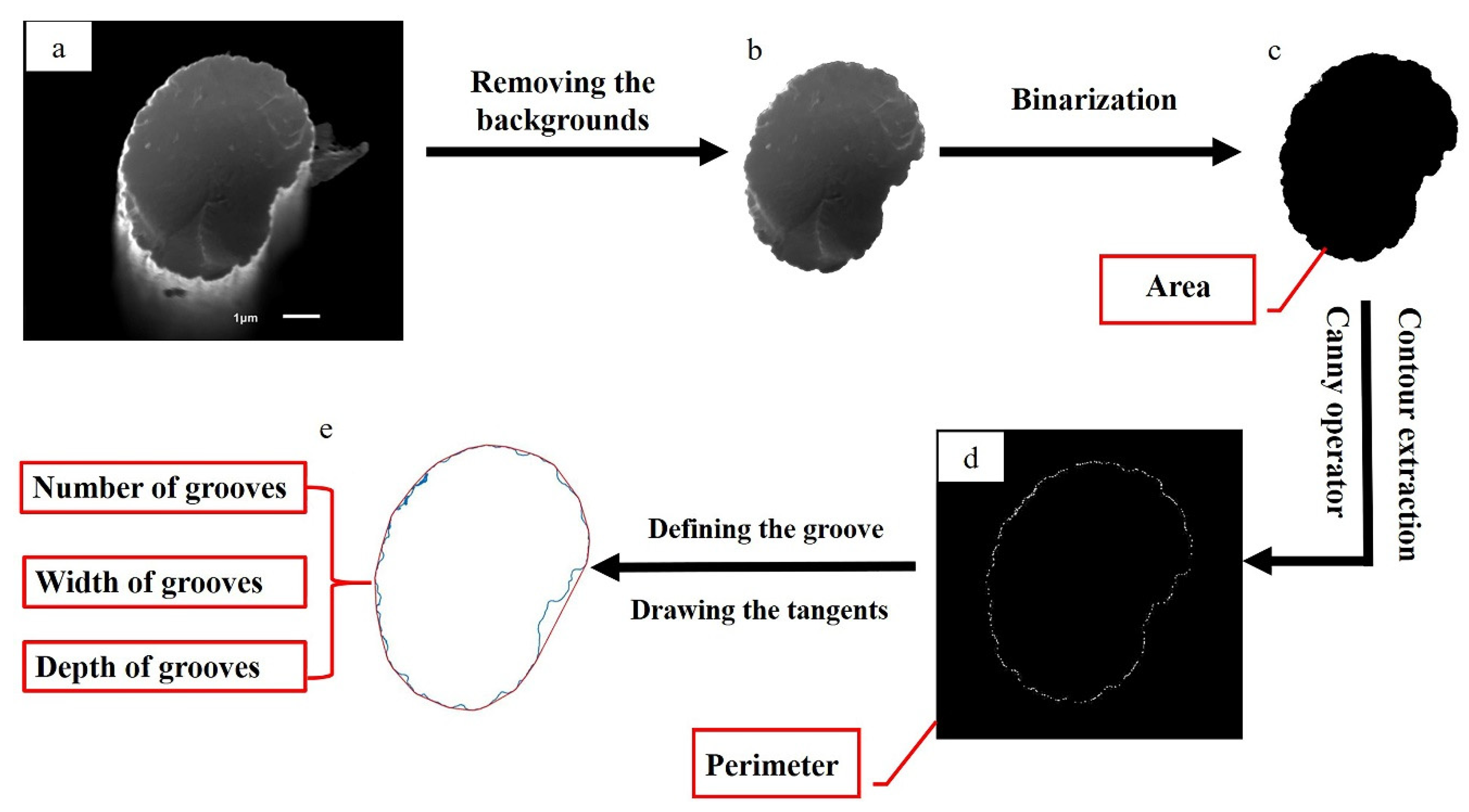
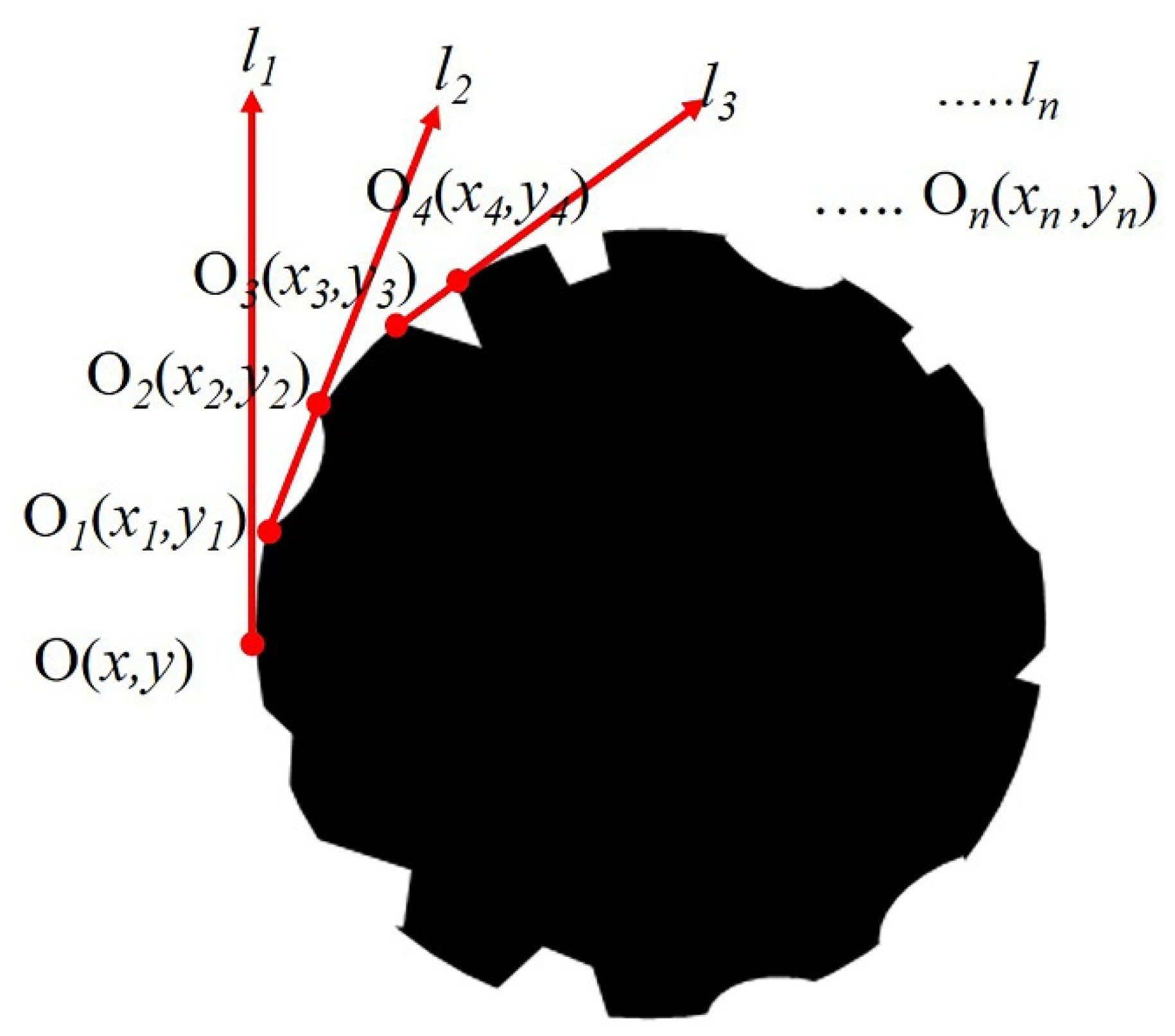
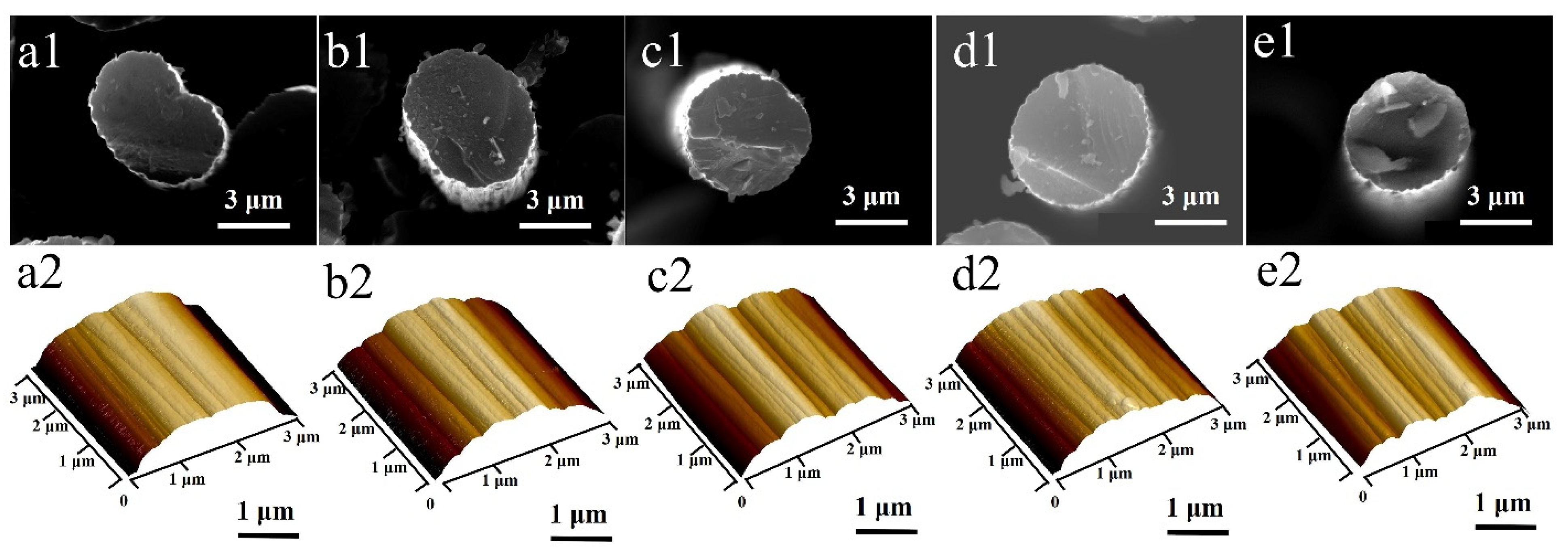
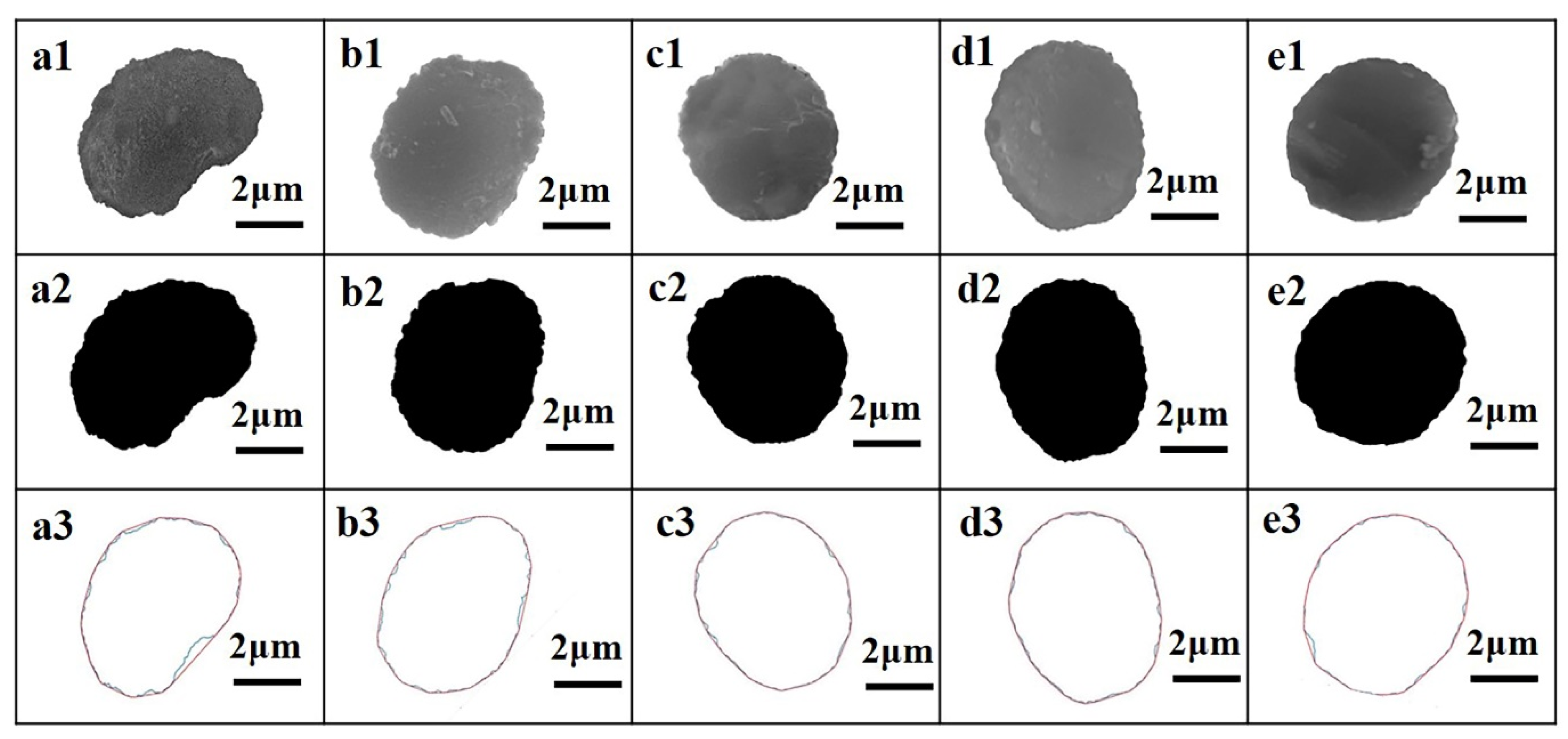
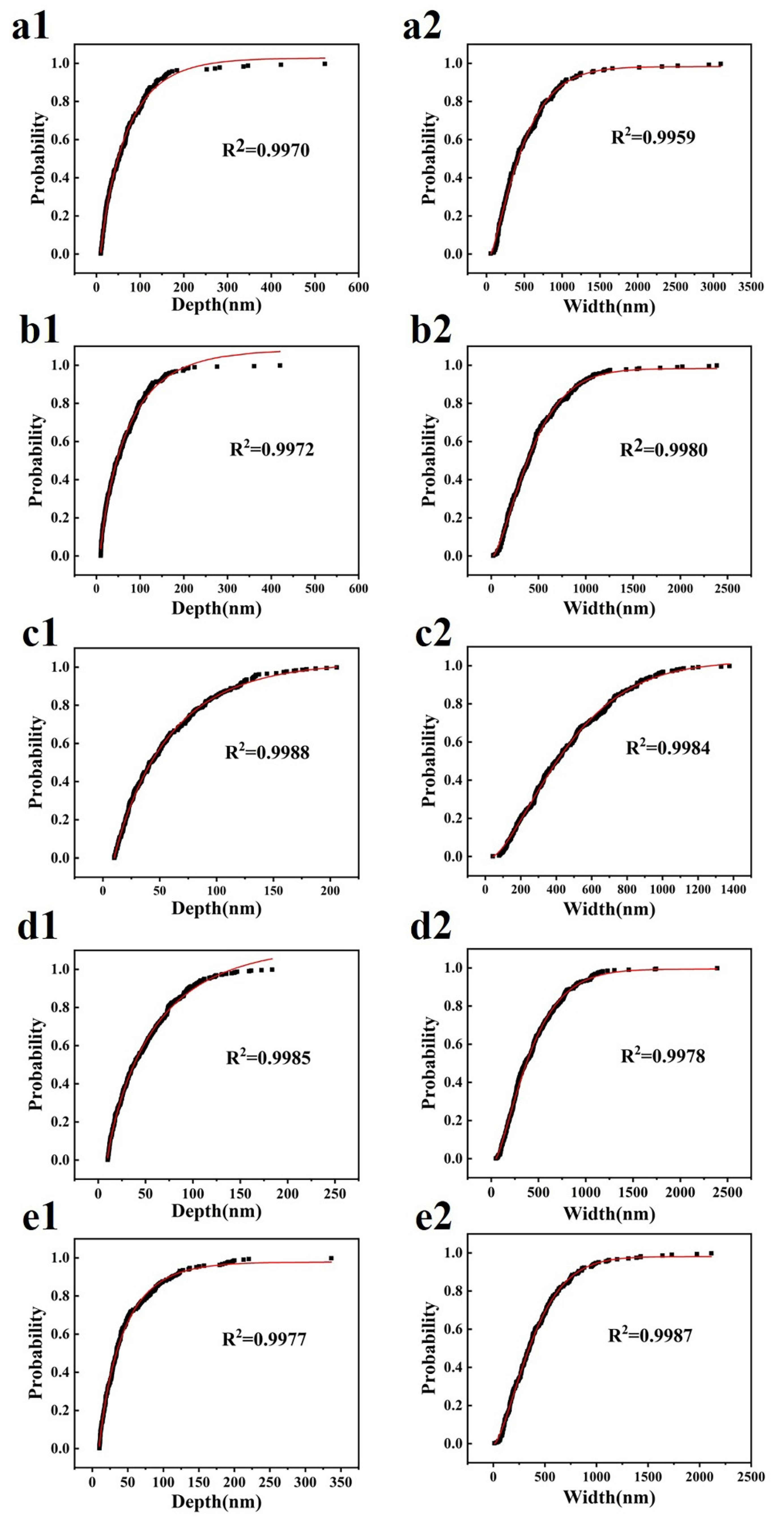

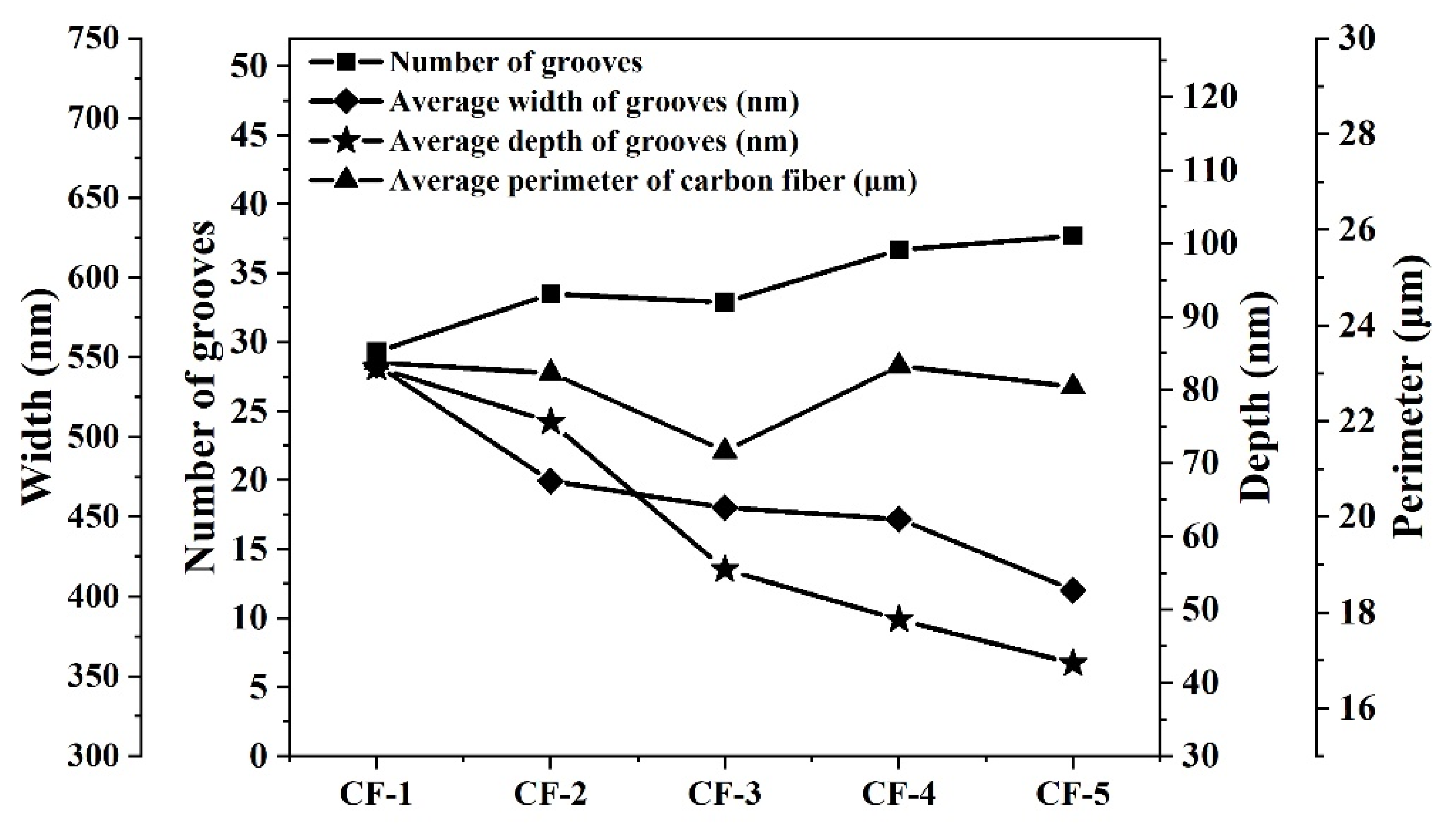
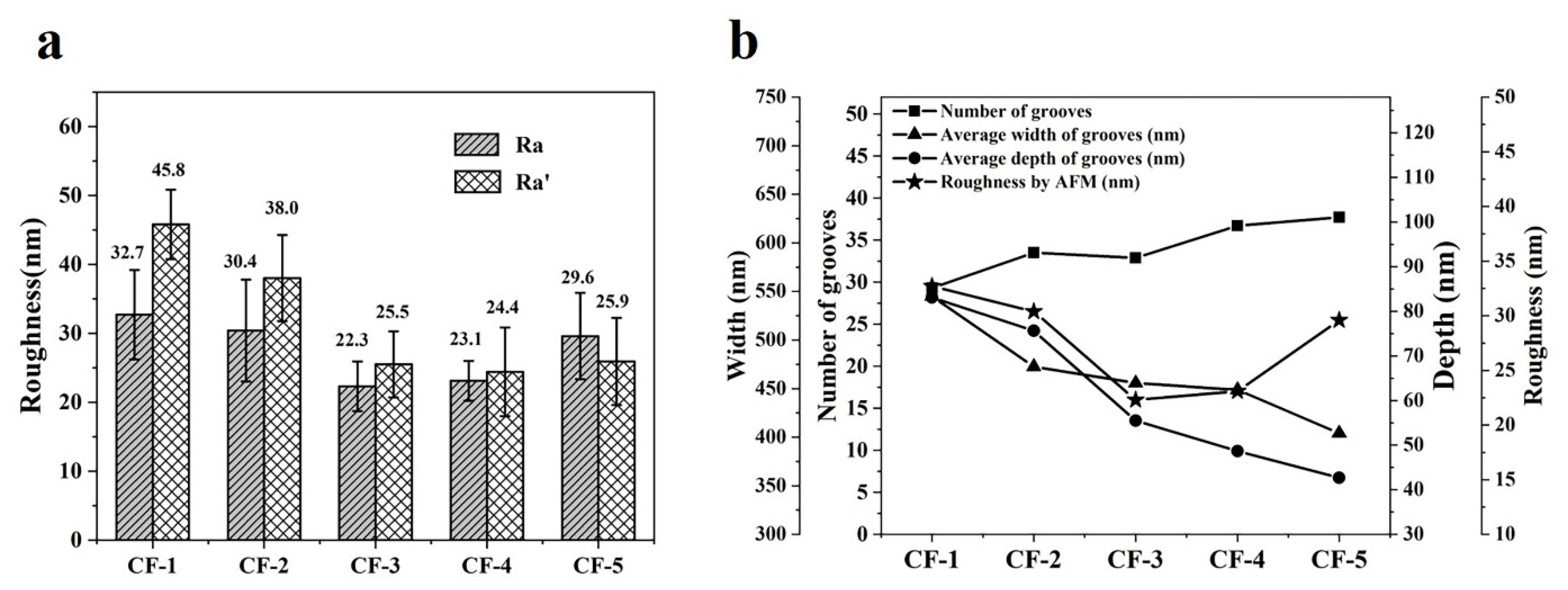
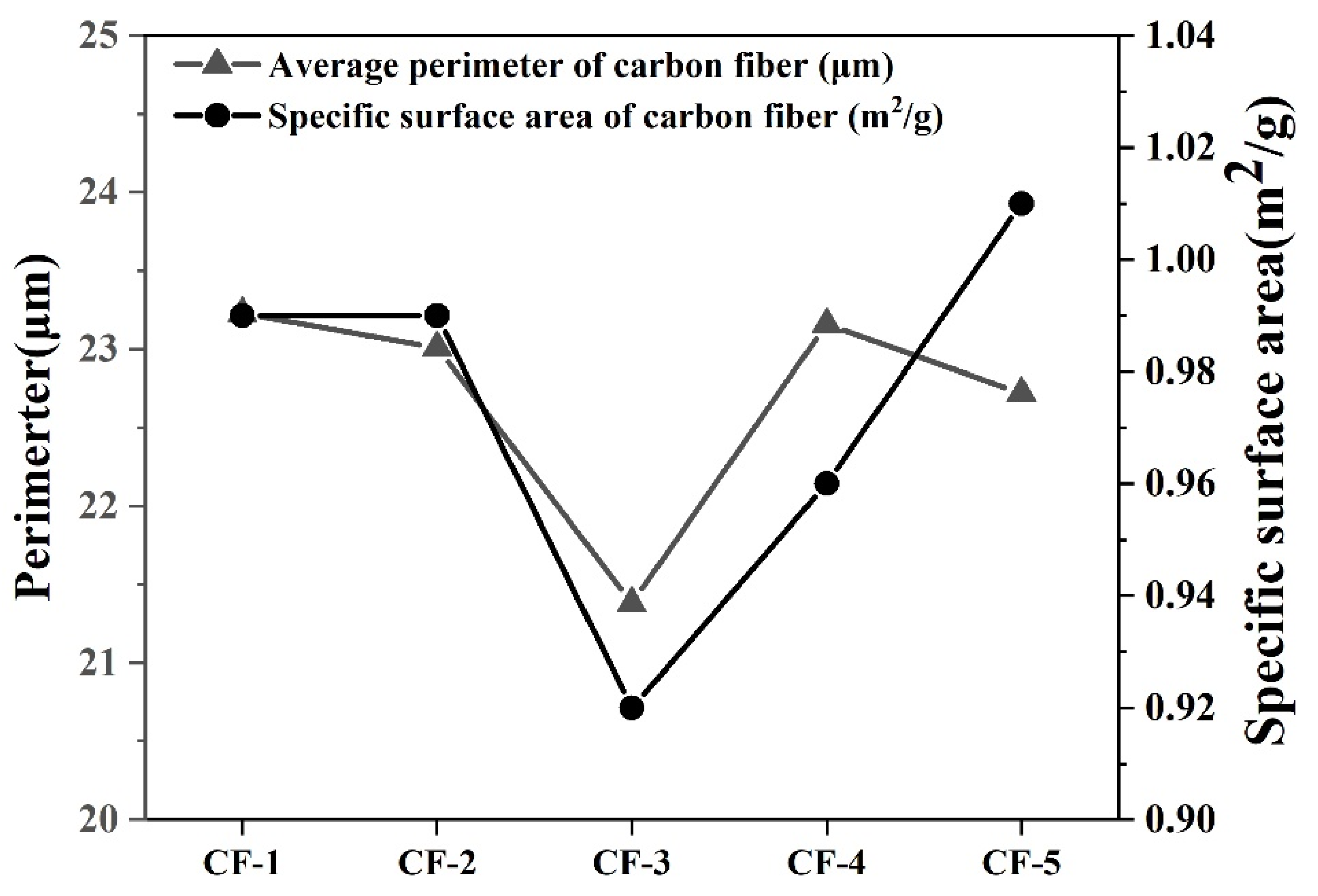
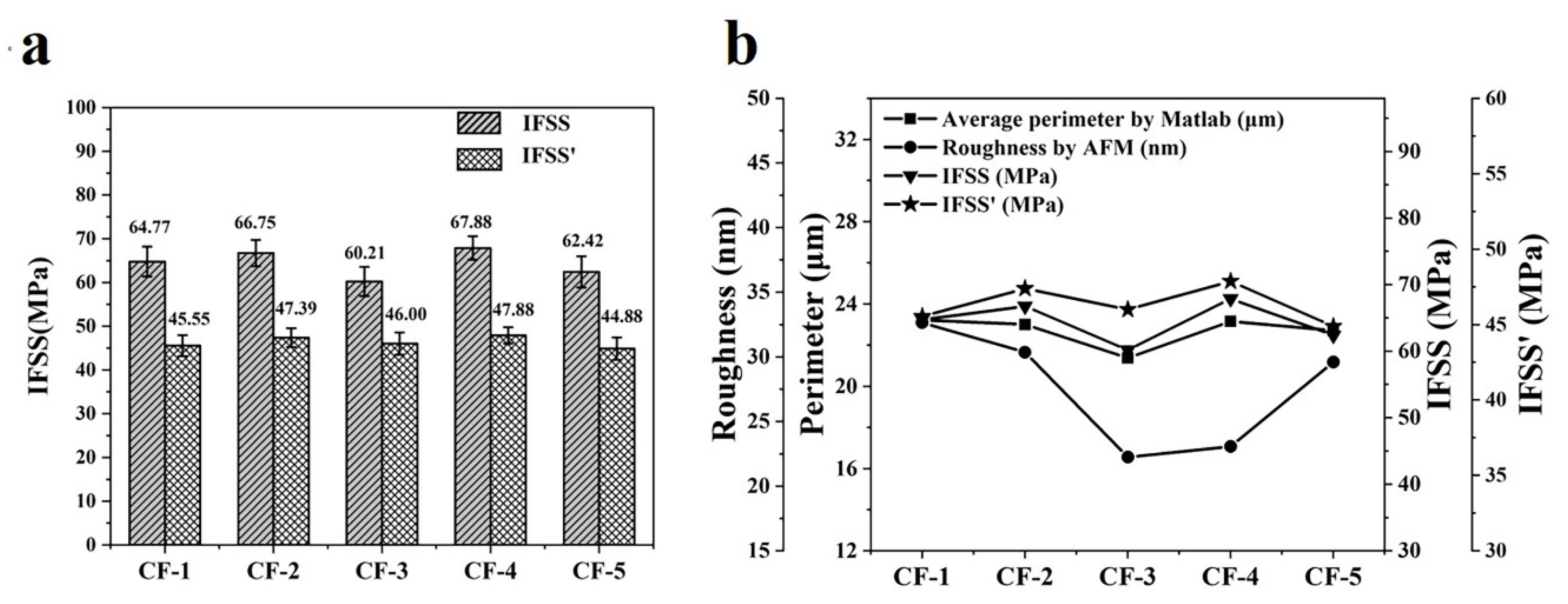

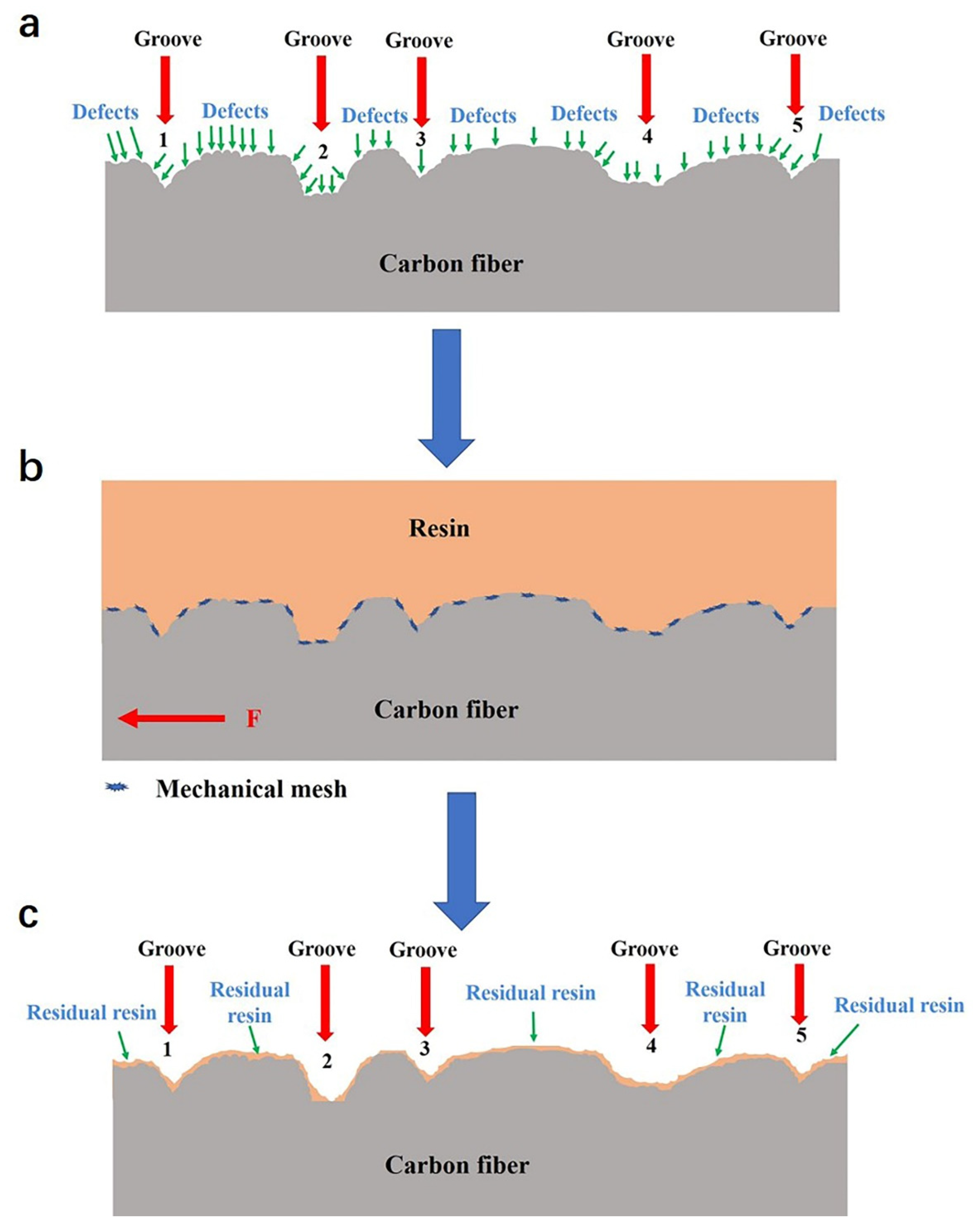
| Samples | CF-1 | CF-2 | CF-3 | CF-4 | CF-5 |
|---|---|---|---|---|---|
| Roughness (Ra, nm) | 32.7 ± 6.5 | 30.4 ± 7.4 | 22.3 ± 3.6 | 23.1 ± 2.9 | 29.6 ± 6.3 |
| Samples | Perimeter (C, μm) | Area (S, μm2) | Roundness Value (α) | Number (N) | Width (W, nm) | Depth (D, nm) | Depth/Width (D/W) |
|---|---|---|---|---|---|---|---|
| CF-1 | 23.23 ± 1.30 | 21.74 ± 1.20 | 0.506 | 29.3 ± 2.8 | 545.05 | 83.08 | 0.15 |
| CF-2 | 23.01 ± 1.29 | 22.11 ± 1.51 | 0.525 | 33.5 ± 3.4 | 472.62 | 75.64 | 0.16 |
| CF-3 | 21.38 ± 0.86 | 20.77 ± 1.01 | 0.570 | 32.9 ± 3.9 | 455.82 | 55.50 | 0.12 |
| CF-4 | 23.16 ± 1.05 | 24.51 ± 1.85 | 0.574 | 36.7 ± 4.8 | 448.69 | 48.66 | 0.11 |
| CF-5 | 22.72 ± 0.98 | 22.38 ± 1.59 | 0.544 | 37.7 ± 5.0 | 404.07 | 42.67 | 0.11 |
| Samples | Diameter (d, μm) | Chemical Element Ratio (O/C) | Composite Interfacial Property | ||
|---|---|---|---|---|---|
| IFSS (MPa) | IFSS’ (MPa) | Percentage Difference (%) | |||
| CF-1 | 5.2 | 0.07 | 64.77 ± 3.42 | 45.55 ± 2.40 | −29.68 |
| CF-2 | 5.2 | 0.08 | 66.75 ± 3.00 | 47.39 ± 2.13 | −29.01 |
| CF-3 | 5.2 | 0.08 | 60.21 ± 3.33 | 46.00 ± 2.54 | −23.59 |
| CF-4 | 5.2 | 0.06 | 67.88 ± 2.67 | 47.88 ± 1.88 | −29.47 |
| CF-5 | 5.2 | 0.07 | 62.42 ± 3.56 | 44.88 ± 2.56 | −28.10 |
Publisher’s Note: MDPI stays neutral with regard to jurisdictional claims in published maps and institutional affiliations. |
© 2021 by the authors. Licensee MDPI, Basel, Switzerland. This article is an open access article distributed under the terms and conditions of the Creative Commons Attribution (CC BY) license (https://creativecommons.org/licenses/by/4.0/).
Share and Cite
Xiong, S.; Zhao, Y.; Song, J. Effect of Carbon Fiber Surface Microstructure on Composite Interfacial Property Based on Image Quantitative Characterization Technique. Materials 2021, 14, 6367. https://doi.org/10.3390/ma14216367
Xiong S, Zhao Y, Song J. Effect of Carbon Fiber Surface Microstructure on Composite Interfacial Property Based on Image Quantitative Characterization Technique. Materials. 2021; 14(21):6367. https://doi.org/10.3390/ma14216367
Chicago/Turabian StyleXiong, Shu, Yan Zhao, and Jiupeng Song. 2021. "Effect of Carbon Fiber Surface Microstructure on Composite Interfacial Property Based on Image Quantitative Characterization Technique" Materials 14, no. 21: 6367. https://doi.org/10.3390/ma14216367
APA StyleXiong, S., Zhao, Y., & Song, J. (2021). Effect of Carbon Fiber Surface Microstructure on Composite Interfacial Property Based on Image Quantitative Characterization Technique. Materials, 14(21), 6367. https://doi.org/10.3390/ma14216367





